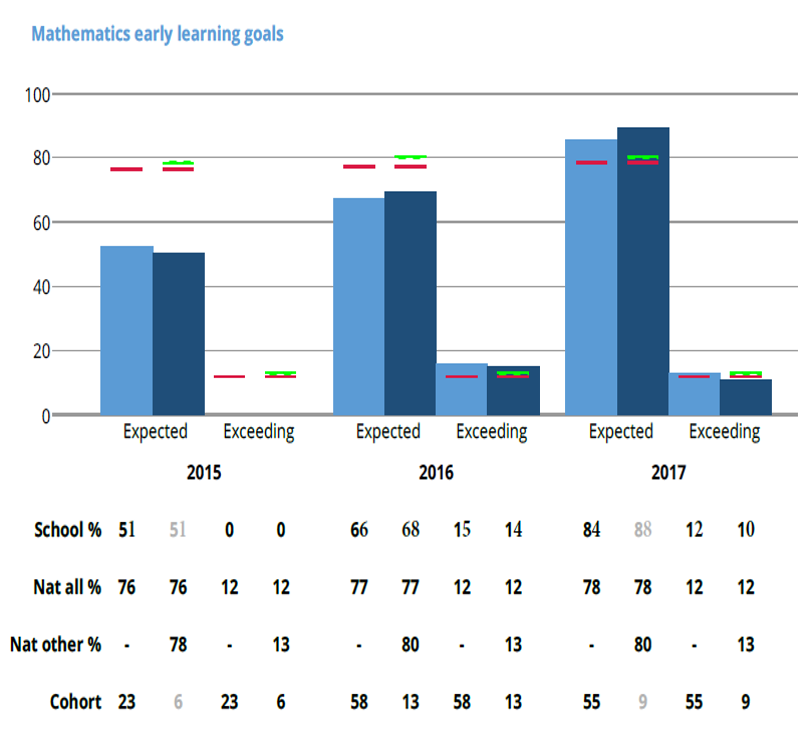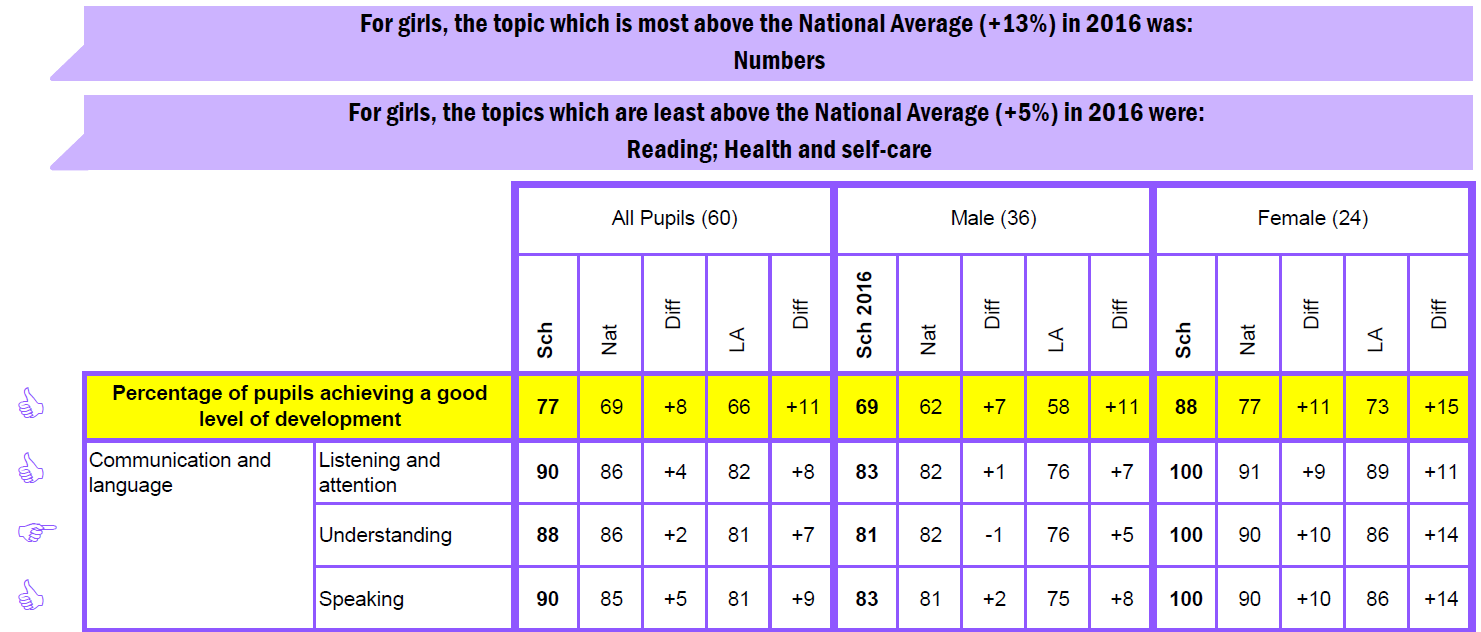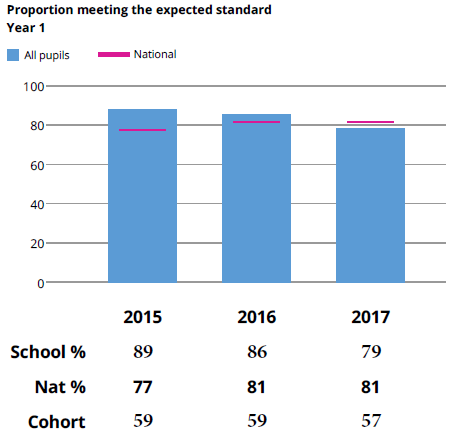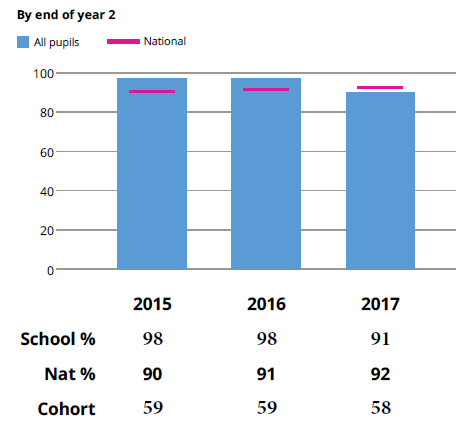
In this series of articles, we’ll be looking at Ofsted’s Inspection Data Summary Report (IDSR).
In the previous article, we had a look at EYFSP Good Level of Development (GLD).
In this article, we’ll have a look at the remainder of the EYFSP analyses, and a look at the Phonics analysis.
Early Years Foundation Stage Profile – ELGs
Following the EYFSP GLD analysis, the IDSR continues with the analysis of Reading ELG, Writing ELG and Mathematics ELGs.

Just as in the EYFSP Good Level of Development analysis:
- The light blue bars represent the school’s performance,
- The dark blue bars represent the school’s performance for FSM pupils,
- The red lines represent the National Average for all pupils,
- The green lines represent the National Average for non-FSM pupils.
For answers to the questions as to why your FSM pupils’ performance is compared with the National non-FSM performance, and what represents a small cohort, please see the early EYFSP analysis.
However, it is made more complicated by the fact that the assessment for each ELG could be:
- Emerging (1),
- Expected (2), and
- Exceeding (3).
This analysis shows the relative percentages for Expected or above (2 or 3), and for Exceeding (3).
It is also made more complicated by the fact that there is not one Mathematics ELG, but two (Numbers, and Shape, space and measures). The IDSR analysis takes the lower of the two.
For example, if a pupil had Exceeding (3) in Numbers and Emerging (1) in “Shape, space and measures”, then the pupil will be marked as not having passed either the Expected standard or above, or the Exceeding standard.
Pupils who were absent in the EYFSP assessments are not included in this analysis.
On the front page of the IDSR there is the “Areas to Investigate”, which is a summary of the IDSR.
- In 2016, when it was called “Strengths and weakness”, then you got a strength if you were above the National Average or below 50% for a Good Level of Development.
- In 2017, EYFSP is not mentioned at all in the “Areas to Investigate”.

Our ASaP reports interprets your Early Years ASP data and shows, in plain English and in tabular form, which of your Early Learning Goals is most above and most below the National Average.
Phonics Analysis
The Phonics test involves your pupils reading 40 words, of which roughly half are “alien” words (like “clud”). A pupil passes the phonics standard if they reach a certain threshold, which has been 32 words since 2012.


Having looked at the EYFSP analysis, the Phonics analysis is very simplistic. Your school’s performance (blue bar) is compared against the National Average (red bar) for:
- Year 1, and
- By the end of Year 2, whether they took the test in Year 1 or Year 2.
It is notable that:
- the “By the end of Year 2” in the IDSR (pupils who took the test in either Year 1 or Year 2) is different to
- the ASP Year 2 Phonics, which is only those pupils who took the test in Year 2.
Pupils who were Absent (A) or Disapplied (D) are treated as having not passed the Phonics analysis.
In our ASaP Phonics Analysis, we interpret your ASP Phonics data for:
- All pupils,
- By Gender,
- Free School Meals eligible pupils,
- Children Looked After pupils,
- Disadvantaged and Non-disadvantaged Pupils,
In the “Areas to Investigate” summary on the front page of the IDSR, you can have a positive comment, based on:
- 90% or more pupils met the Phonics Expected Standard in Year 1.
You can also have the following negative comment:
- Fewer than 70% of the pupils met the Phonics Expected Standard in Year 1.
In 2016, you could also have weaknesses based on the level of Phonics attainment in Year 2 (80%), but this was not used in 2017.
You can also get the following ambiguous comment:
- The average mark for pupils not meeting the phonics expected standard in year 1 was [number].
It is not clear why this comment has been included, nor what weight Ofsted has attached to it. For example:
- If the average mark is 7 (for example), then this probably means that you have a lot of pupils who correctly decoded zero or one words. This would indicate a challenging cohort.
- Alternatively, if the average mark is (for example) 25 then, given the maximum mark a pupil can have without passing is 31, this would indicate a lot of pupils almost passing.
How would Ofsted interpret either of these situations? As we said, it does not appear that this comment has been significantly used in the Ofsted judgements.
Additionally, this comment will only be shown is a minimum of 11 pupils took the test and did not pass. This would principally affect bigger schools.
In the next article, we’ll start to look at the Key Stage 1 analysis.
This FREE training course is also Available for FREE as a video learning course on our YouTube Channel.
- Learn at your speed (can be paused and restarted)
- Use on the go (over internet)
- Great for School Governors and School Leaders
